|
|
|
Sort Order |
|
|
|
Items / Page
|
|
|
|
|
|
|
| Srl | Item |
| 1 |
ID:
161847
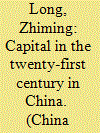

|
|
|
|
|
| Summary/Abstract |
We propose a method of constructing a general capital stock à la Piketty for China from 1952 to 2015 (Part 1). The elasticities of income with respect to this capital are econometrically estimed through equations which also integrate human capital and R&D. The tests are performed within frameworks of modern neoclassical macrodynamic models. On this basis, we calculate an implicit rate of return of capital to test the validity of what Piketty states as a “fundamental inequality”, comparing rate of return on capital and income growth rate in the long run. This inequality is verified, but appears to be tendentiously challenged over the last decade. Then, Piketty's “second law”, arguing that the coefficient of capital tends to be equal to the ratio between savings rate and income growth rate, is examined. This “second law” is to be viewed as a process of asymptotic convergence in the long term (Part 2). These results are compared with new estimates for the post-1978 sub-period of “capitalism with Chinese characteristics”, but the fundamental inequality is no longer verified, and it is not reasonable to affirm the validity of the “second law” (Part 3). Finally, we address the issue of the inequalities in China.
|
|
|
|
|
|
|
|
|
|
|
|
|
|
|
|
| 2 |
ID:
161866
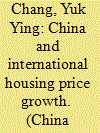

|
|
|
|
|
| Summary/Abstract |
We document Chinese effects on international residential property price growth. We show that faster growth of the housing prices is associated with larger declines in recent past growth of China's GDP, larger increases in China's savings rate, or stronger rise in China's risks. These results are consistent with the notion of Chinese investing in overseas property markets when faced with less promising investment opportunities at home and when they have the means to invest offshore. These effects are stronger for countries where English is the primary spoken language, with better tertiary education quality, and that exhibit lower correlations between local property market price growth and China's interest rate.
|
|
|
|
|
|
|
|
|
|
|
|
|
|
|
|
| 3 |
ID:
161867


|
|
|
|
|
| Summary/Abstract |
This paper estimates the effects of a nation-wide rural electrification program in China using an informative dataset for 2459 Chinese villages. The combined propensity score matching and difference-in-differences approach is adopted to address potential selection bias. Accordingly, the program can significantly increase the net agricultural income per capita of farmers in the targeted villages. Moreover, matching grants with private assets and obligation labor force both can increase the effectiveness of the program. The program also highlights the complementarity between infrastructure and institution, in which the introduction of grassroots democracy will increase the effectivity of the rural electrification program.
|
|
|
|
|
|
|
|
|
|
|
|
|
|
|
|
| 4 |
ID:
161840
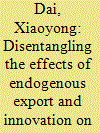

|
|
|
|
|
| Summary/Abstract |
This paper disentangles the effects of export and innovation on firm-level markup and productivity. Based on a large sample of Chinese manufacturing firms, we explicitly account for firms' endogenous export and innovation decisions, and isolate their impacts on firms' future performance, using a propensity score matching approach with multiple treatments. The results indicate that starting to export alone negatively affects firm-level markup and productivity, while starting to innovate alone has a significant positive impact. There is a complementarity between export and innovation in improving firms' performance. The negative effect of starting to export alone on revenue productivity may reflect the decrease of price-cost markup, rather than a change in physical productivity. Our study contributes to explaining puzzling results of exporter performance for China. The results also suggest that firms should establish domestic market power through innovation before turning to export markets.
|
|
|
|
|
|
|
|
|
|
|
|
|
|
|
|
| 5 |
ID:
161841
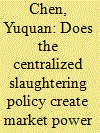

|
|
|
|
|
| Summary/Abstract |
In order to ensure safe meat supply and protect consumers' health, the government of China made a law in 1997 which started to enforce centralized slaughtering of hogs in licensed slaughtering houses. We use a structural model and the industrial level data to test the hypothesis that whether the “centralized slaughtering policy” creates market power. The results detect sizable and significant market power (about 0.5% price margin) for the slaughtering industry in the pork supply chain, mainly due to high barriers of entry and stringent license regulations which reduce competition in the market. The total profit markup for the slaughtering industry reaches 1.85 billion yuan just in 2016. The welfare transfer and loss from market power should be taken into account for such a policy making.
|
|
|
|
|
|
|
|
|
|
|
|
|
|
|
|
| 6 |
ID:
161843


|
|
|
|
|
| Summary/Abstract |
China's stimulus plan in 2009–2010 brought local government financing vehicles (LGFVs) and new types of land finance into the spotlight. This paper uses national parcel-level land transaction data to examine the causes and consequences of LGFVs' land purchasing behavior in China. We found that LGFVs overbid significantly in terms of land prices. We explore channels through which LGFVs bid high prices for land. The stimulus plan induced local government to increase debt and rely more on land-based mortgages and land leasing revenue. Fiscal pressure led to an increase in LGFVs bidding for land. We found that the stimulus plan changed local governments' control over land leasing and land finance. Local governments hold more of the land market and inflate land prices following implementation of the stimulus plan.
|
|
|
|
|
|
|
|
|
|
|
|
|
|
|
|
| 7 |
ID:
161837


|
|
|
|
|
| Summary/Abstract |
This paper studies corporate investment and its structural change by the view of state-owned property right. By constructing dynamic investment decision-making model, we find corporate investment heterogeneity in China due to their different dynamic shifts of objective functions, demonstrated by our simulations. Empirical tests imply that the expansion of investment improves financial performance, but does not play a positive role on solving social employment. POEs expanded investment much more than SOEs did, even in the transitional period, but both of them reduced their investment significantly in new normal. Mechanisms are explored by 3-stage structural models for non-matched control group and nearest neighbor PSM matched control group. Although investment inefficiency of SOEs are concerned, executive stock ownership and equity finance could be exotic methods to stimulate efficient investment. Investment efficiency of POEs has been recovered in new normal but POEs have shifted away from ‘profit-driving’ they used to be in the old normal.
|
|
|
|
|
|
|
|
|
|
|
|
|
|
|
|
| 8 |
ID:
161846
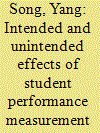

|
|
|
|
|
| Summary/Abstract |
In the past few decades, the Chinese Ministry of Education has promoted “suzhi jiaoyu” (quality education) reforms. However, little is known about their impact. This paper evaluates an important component of the reforms that replaces using total scores with a letter grade system in high school admissions. I find that this change in student performance measurement achieved its intended goal of balancing learning across subjects but hindered high achievers with imbalanced performance. This paper also discusses how the measurement reform influenced the gender gap in achievements.
|
|
|
|
|
|
|
|
|
|
|
|
|
|
|
|
| 9 |
ID:
161862


|
|
|
|
|
| Summary/Abstract |
How does land institution affect economic growth? This paper proposes a simple model showing that, in an institution that land is owned and supplied by the state, local governments tend to increase investment in infrastructure when holding a larger share of land conveyance revenue in the total revenue. The main channel is that land conveyance revenue serves as a signal of credit quality of local governments. To test the model of land financing, this paper employs an exogenous event of the deregulation of local government debt in China in 2009. Using county-level data in China, empirical results suggest that counties with a higher initial share of land conveyance revenue were growing faster after 2009. The land-financing effect was persistent and even stronger during 2009 to 2014. Results are robust using geographic plainness as the instrumental variable measuring the amount of developable land resources. There is also consistent evidence on the growth of night light intensity.
|
|
|
|
|
|
|
|
|
|
|
|
|
|
|
|
| 10 |
ID:
161844
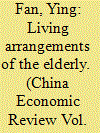

|
|
|
|
|
| Summary/Abstract |
As the foundation of elderly care, living arrangements are closely connected with the physical and psychological well-being of the elderly and the social resources allocation. The objective of this study is to understand the constraints between the preferred and actual choices of elderly living arrangements in China. We first establish a standardized theoretical model and derive two hypotheses on choice constraints. Based on the CHARLS database, we empirically test the theoretical hypotheses based on multiple-step empirical tests. Our findings are as follows. 1) The correlation between elderly income and the likelihood of living with their children is nonlinear: when the elderly prefers to live apart, their higher absolute income provides a greater likelihood that they can do so, and when they prefer to live with their children, the relative income of the elderly and their children are important in the likelihood of living together. 2) The poorer the health status of the elderly, the greater likelihood that they live with their children, particularly if they have daughters. The results are robust after controlling for the potential endogeneity issue, the passive choice situation, and volatility in preference.
|
|
|
|
|
|
|
|
|
|
|
|
|
|
|
|
| 11 |
ID:
161863


|
|
|
|
|
| Summary/Abstract |
We derive the conditions under which a manager will divert and how managerial diversion affects product market performance and firm profits. Our model predicts that managerial diversion is more likely to occur and leads to more aggressive product market behavior in a firm with weak incentives and corporate governance. In these firms, the relation between managerial diversion and firm profits is inverse U-shaped. Chinese state-owned manufacturing firms are used to test our theoretical model, and we find supportive evidence.
|
|
|
|
|
|
|
|
|
|
|
|
|
|
|
|
| 12 |
ID:
161845


|
|
|
|
|
| Summary/Abstract |
This paper examines China's money demand using a Normalized Quadratic function in the search for global flexibility and easing of the degree of freedom. I impose the theoretical regularity conditions in the model that much of the previous literature ignores. I provide the robust estimates of the Morishima elasticities of substitution among currency, demand deposits and time deposits. I find that currency and demand deposits are elastic substitutes in use, while time deposits are inelastic substitutes with the former two. Time deposits are distant from a medium of exchange, and agents treat them as a saving asset, separable from the composite of currency and demand deposits. The results imply that the narrow money M1 is well-defined, while the broad money M2, which assumes perfect substitution of the component assets, is problematic. A monetary aggregate that internalizes the substitution effects should be adopted in China.
|
|
|
|
|
|
|
|
|
|
|
|
|
|
|
|
| 13 |
ID:
161839
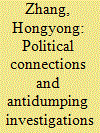

|
|
|
|
|
| Summary/Abstract |
Do political connections affect antidumping (AD) investigations? To address this question, we use antidumping filings data combined with micro data on Chinese manufacturing firms for the period 1998–2007. The political connections of a firm are defined by whether it has state-owned capital or whether it is under the administration of central or provincial government. Estimating a probit model of AD filings at the firm level, we find that strong political connections significantly increase the likelihood of AD petitions and affirmative final dumping decisions. State-owned enterprises, firms affiliated with the central or provincial government, low productivity firms, and large firms tend to file AD investigations in China. The industry-level estimation results also confirm that the industries with a greater presence of state-owned enterprises are likely to apply for and receive trade protection from the Chinese government, controlling for import penetration, year, and industry fixed effects.
|
|
|
|
|
|
|
|
|
|
|
|
|
|
|
|
| 14 |
ID:
161865


|
|
|
|
|
| Summary/Abstract |
This study investigates the effect of political promotion incentives on the labor investment efficiency of firms by focusing on human capital misallocation. We show that 1) promotion incentives of local politicians significantly increase firm-level employment growth and decrease labor investment efficiency. 2) Causality is established using the number of death toll in local mining accidents to isolate exogenous shocks on the promotion incentives of local politicians, and placebo tests further confirm the causality. 3) For under-hiring firms, promotion incentives only increase the employment of low human capital, thus distorting human capital structure and decreasing labor investment efficiency. 4) Our findings are robust to alternative specifications. Overall, we highlight the political economy channel of human capital misallocation from the perspective of career concerns of local politicians.
|
|
|
|
|
|
|
|
|
|
|
|
|
|
|
|
| 15 |
ID:
161864
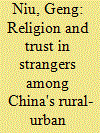

|
|
|
|
|
| Summary/Abstract |
During China's rapid urbanization, the social marginalization of its rural-urban migrants has attracted increasing scholarly and social attention. At the same time, China is experiencing a rising tide of religion, the impact of which on social integration remains unexplored. Based on a large-scale survey for rural-urban migrants, we find that being a religious believer is associated with a higher level of trust towards strangers. In addition, participating in religious-related activities has a positive impact on trust for both believers and non-believers. We test the robustness of our results using instrumental variable analysis. We conjecture that prosocial values in religious teaching and social interaction opportunities contribute to rural-urban migrants' generalized trust. Our results indicate that informal institution such as religion can be important in forming social capital for marginalized social groups.
|
|
|
|
|
|
|
|
|
|
|
|
|
|
|
|
| 16 |
ID:
161842


|
|
|
|
|
| Summary/Abstract |
The rise of non-communicable diseases has placed enormous stress on health systems leading to calls for improved prevention. This article examines the association of risk factors and non-communicable disease diagnosis in China using longitudinal data which enables us to control for important simultaneity bias. Using three waves of the China Family Panel Studies (CFPS) survey (2010–2014) and a dynamic model conditional on not having an NCD in the first period, we find positive association of being obese, using solid cooking fuels, history of frequent drinking, and household consumption expenditure during the preceding period on non-communicable disease onset. We find significant heterogeneity in risks across the population suggesting that a targeted policy response is required to reduce the burden of non-communicable disease in China.
|
|
|
|
|
|
|
|
|
|
|
|
|
|
|
|
| 17 |
ID:
161848
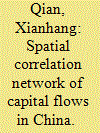

|
|
|
|
|
| Summary/Abstract |
Using data from China's High-Value Payment System, this paper directly and precisely measures interregional capital flows in China and analyzes their spatial correlation. Using social network analysis methods, this study finds a spatial correlation network between interregional capital flows. The closeness of the network is strong and has a high stability. Different provinces exhibit different positions in the network. Beijing, Jiangsu, Shandong, Shanghai, and Zhejiang are at the relative core, while Qinghai, Xinjiang, Guangxi, Anhui, and Tibet are at the periphery. According to a block model, the eastern provinces belong to a bidirectional spillover block, the middle provinces are in a primary beneficial block, and the western provinces are in a net beneficial block. Based on a quadratic assignment procedure regression analysis, the paper concludes that geographical distance and differences in provinces' fixed asset investments, foreign direct investments, and marketization levels are important factors that impact the spatial correlation of capital flows. The conclusions of this paper are significant for the formulation of a regional coordinated strategy in China.
|
|
|
|
|
|
|
|
|
|
|
|
|
|
|
|
| 18 |
ID:
161838


|
|
|
|
|
| Summary/Abstract |
An important environmental consequence of subsidies for fossil fuels is that it encourages the substitution from renewable energy, capital and labor to fossil fuels, and thus impedes the low carbon transition. To reduce energy consumption and energy-related greenhouse gas emissions, there is a renewed interest in phasing out fossil fuel subsidies. In policy debates, it is commonly believed that fossil fuel subsidies encourage wasteful energy consuming, and thus removing them would depress energy-related carbon dioxide (CO2) emissions. But whether it is the real case and the magnitude of mitigation by removing fossil fuel subsidies are still unanswered. Here we provide an opposite insight in this paper. We find that fossil fuel subsidies in China might have been removed in total in 2015, but further attention should be paid to whether the removal is caused by the market condition of low energy prices, or by the on-going market-oriented reforms. Furthermore, during the periods with positive subsidies, removing fossil fuel subsidies alone cannot achieve CO2 mitigation because it would lead to the substitution from low-emitted fuels to high-emitted coal and from capital and labor to energy. Our results demonstrate that additional policies and efforts will be required to fulfill the aspirations for low carbon economy. The findings in this paper may be extended to emerging and developing countries due to their similar conditions of fossil fuel subsidies.
|
|
|
|
|
|
|
|
|
|
|
|
|
|
|
|
| 19 |
ID:
161861


|
|
|
|
|
| Summary/Abstract |
This paper studies the wage penalty of overeducation using the World Bank's STEP (Skills Towards Employability and Productivity) survey in China. Based on the measurements of cognitive, technical, and non-cognitive skills, the overeducated have systematically lower abilities compared with the well-matched, just as the skill heterogeneity theory predicts. Endogenous switching model is adopted to estimate the effect of overeducation on wage. We find that the overeducated workers with tertiary education suffer from significant loss compared with the well-matched workers, while overeducation has no significant effect on workers with high school education. The causality inference using nearest neighbor matching and propensity score weighted regression methods reveals that our conclusions are robust.
|
|
|
|
|
|
|
|
|
|
|
|
|
|
|
|
|
|
|
|
|